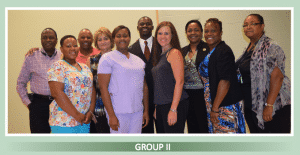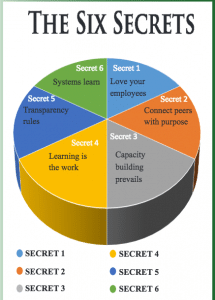McComb’s Strategic Planning Begins with the Community
CompetencyWorks Blog

This is the third post on a series about McComb School District in McComb, Mississippi. Start here.
In 2014, McComb developed a strategic plan that would guide them toward a personalized system. This article has three sections: engaging the community, developing the strategic plan, and highlights of the strategic plan.
Engaging the Community
The strategic planning process began with community conversations. Superintendent Cederick Ellis explained, “Too often initiatives and reforms either come from the state or are dependent on the district leader. The problem is when the funds are gone or when the leader leaves, the reforms go as well. We didn’t want learning to be driven by one person. We were intentional in involving community. If they hadn’t wanted personalized learning, we couldn’t have made it successful. Our community had to believe in it. The wishes of the community are embedded in the strategic plan. Our job is to institutionalize it so that this is just the way we are going to do our business.”
They were so committed to having authentic dialogue that Ellis didn’t even attend. Instead, they hired a facilitator to ensure a safe and respectful conversation where everyone would be heard. It’s worth mentioning here that at the top of the guiding beliefs produced though this planning process is Every individual matters, therefore, his or her opinions and voice should be heard, represented, and respected.
 The conversations included a number of activities to provide opportunity for community members to encounter new ideas, reflect, and engage with each other. This include a gallery walk to look at data and discuss what it meant; a look at how the traditional system is designed and how it limits learning; and district-created posters on different issues. They also brought what they had learned at the Educational Achievement Authority in Michigan District back to the community through videos, including some where children talked about how personalized learning had impacted their lives. It helped community members imagine what school could be. High school students talked about where they would be now if they could have this education and how it would have changed their educational journeys.
The conversations included a number of activities to provide opportunity for community members to encounter new ideas, reflect, and engage with each other. This include a gallery walk to look at data and discuss what it meant; a look at how the traditional system is designed and how it limits learning; and district-created posters on different issues. They also brought what they had learned at the Educational Achievement Authority in Michigan District back to the community through videos, including some where children talked about how personalized learning had impacted their lives. It helped community members imagine what school could be. High school students talked about where they would be now if they could have this education and how it would have changed their educational journeys.
There were also special sessions with school board members so that community members had an opportunity to see what personalized learning could look like and what the implications would be for the district and schools.
The outcome of these meetings was that community members wanted something different than the status quo. It’s an interesting dynamic: If the status quo is simply unacceptable, then the school district has to move forward. A follow-up survey to a wide swath of stakeholders confirmed that the community wanted to take a step in a new direction and provided insights into preferences. (You can find the survey findings in the strategic plan.)
Developing the Strategic Plan
Thirty-five people participated in developing the strategic plan, including teacher leaders and school administrators; business, religious, and civic leaders; parent and student leaders; and representatives from higher education. The goal of the strategic planning working group was to develop a bold vision to guide McComb. They used five guiding questions to push their thinking, focused on three aspects of the school system (core of exemplary teachers; curriculum, pedagogy, and delivery systems; and development of model schools), thought about the culture that was needed to sustain personalized learning, and considered the alignment with businesses and higher education.
Guiding Questions
- What does being a world-class school mean for the City of McComb and the McComb School District?
- What are the most important elements of a world-class school or school district?
- What is the foundation of excellence in McComb that might serve as a starting point for the journey toward excellence?
- What are the barriers to exemplary performance and outcomes?
- Who are the people and what resources do they need to lead the district to the upper tier of educational excellence?
 McComb pays attention to culture. One of the starting points for building the culture to support personalized learning was the integration of The Six Secrets of Change by Michael Fullan into the strategic planning process:
McComb pays attention to culture. One of the starting points for building the culture to support personalized learning was the integration of The Six Secrets of Change by Michael Fullan into the strategic planning process:
- Love your employees.
- Connect peers with purpose.
- Capacity building prevails.
- Learning is the work.
- Transparency rules.
- Systems learn.
Reflection: I wasn’t familiar with these six secrets and was struck by how similar they are to the beliefs of competency-based education. When reading Fullan’s article I began to wonder… As we move toward more fully developed competency-based systems, are we in fact building organizations where “learning is the work” for students, adults, and the organization?
The Working Group considered two mediating factors in developing their plan: the social and economic factors that were impacting families and children, and what it would mean to align with industry and higher education. The town of McComb has faced and is continuing to face significant challenges, some quite similar to Eminence, Kentucky: a rapidly declining population over the past decade that leaves a higher proportion of low-income families; few large employers outside of public services; and an ever-shrinking funding of what was already very low compared to other states. McComb has a solid middle class, and previous efforts to improve education have led to increases in graduation rates. The economic future is based on a blossoming oil industry with expectations for population growth in Pike County. It is also important to understand that the racial dynamics that have haunted Mississippi continue with the McComb School District competing with an increase of mostly white private academies and neighboring districts that are part of the Mississippi legacy of segregation.
Four Criteria for Developing Recommendations
McComb’s established four criteria before they began developing recommendations. This is a strong protocol that can build trust, especially when when participants create the criteria and then use them in the analysis of different options.
Four Criteria
1. High Leverage—will the recommendation, after successful implementation, result in maximum impact and outcomes on students, schools, and the McComb School District?
2. Linkage to Existing Capacity—are there existing human, material, and/or program resources to ensure the successful implementation of the recommendation?
3. Timing—is it likely that the recommendation can be fully, or partially, implemented by the close of the strategic planning period in 2018?
4. Sustainability—once implemented, can the recommendation continue beyond the strategic planning period and the tenure of the current superintendent and school board members?
The Strategic Plan
After three months of work, the process produced a strategic plan that was brought to the school board for review and approval. Parts of the plan are highlighted below:
Mission: The McComb community, although facing challenges, was primarily driven by a sense that their children deserved better and set the vision at becoming world-class.
The mission of the McComb School District is to become a premier, world-class school system where student success is inevitable and each student is cultivated to become fierce competitors in a global society.
Guiding Beliefs: Guiding beliefs are a powerful way to help community and school board members, educators, parents, and students understand the difference between where they have come from and where they are going. They can be used to align behavior around new values and open up conversations to look at underlying rationale. McComb’s is particularly powerful, as the first belief is about valuing (respecting) everyone’s voice and empowerment.
- Every individual matters, therefore, his or her opinions and voice should be heard, represented, and respected
- Every individual should have the opportunity to achieve his or her goals and dreams
- People should open their minds to new ideas
- Collaboration and cooperation are essential for success
- Communities should be highly engaged
- Every individual can rise to high standards
- Every individual should be held accountable
- Character counts
Recommendations: The strategic plan also includes a set of Recommendations for Launching the Strategy for Personalized Learning: The recommendations are more concrete and essentially create a four-year work plan for the district and community. Examples of recommendations include:
- Model schools – STEM academy at Summit and Kennedy Early Childhood Center – as launch of roll-out strategy.
- Replace letter grade reporting with Skills Based Reporting in the early grades, PreK to 2nd grade.
- Develop a no-retention policy for students from PreK to 2nd grade. (MS requires retention at 3rd grade for students not at grade level)
- Departmentalize teaching and learning in grades 5 through 8. Doing so will require teachers to expand their content knowledge and pedagogy in specific subject areas. Additionally, the teaching of Algebra at grade 5 will become a departmental responsibility versus requiring all 5th grade teachers to teach Algebra.
- Beginning with the 2016-2017 academic year, every student in the early grades, PreK to the 3rd grade, are to have access to a personal, mobile computing device.
- All 11th grade students should be required to take the ACT. Prior to taking the ACT, all students are to complete an ACT preparation course.
Instructional strategies emphasized in the strategic plan include:
- By introducing Problem Based Learning (PBL) into the pedagogic practice, the McComb School District will afford all students the opportunity to showcase their best work.
- Art education is essential to critical thinking, problem solving, creative innovation, and cognitive development.
- All teachers in PreK-3rd are to be certified in literacy by the 2016-2017 academic year.
In the next article, we’ll look at how McComb prepared for change.
Read the Entire Series:
- Post 1 – Personalizing the Learning in McComb, Mississippi
- Post 2 – McComb’s Six Pillars of Student-Centered Learning
- Post 3 – McComb’s Strategic Planning Begins with the Community
- Post 4 – Piloting Change in McComb
- Post 5 – Empowering Scholars at McComb’s Summit Elementary
- Post 6 – Starting with the Kindergarteners in McComb
- Post 7 – Starting the Journey to CBE at Otken Elementary School
- Post 8 – Supporting Practitioners in McComb